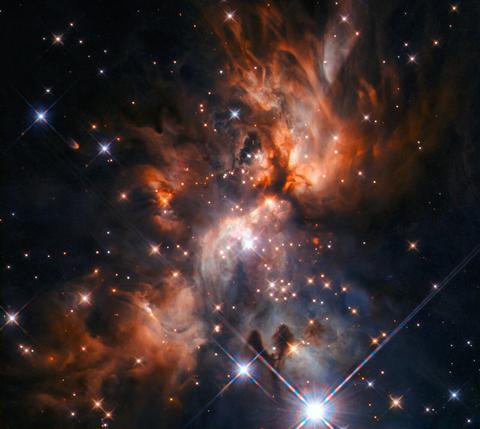
Hubble Telescope image - March 15, 2021
US and European officials have announced December 24th, 7:20 A.M. EST for the launch of the James Webb Space Telescope. A $10 billion successor to the Hubble Space Telescope, it is scheduled to lift-off from French Guiana. This observatory is designed to look deeper into the universe than its predecessor, detecting events occurring further back in time--more than 13.5 billion years ago. Scientists also want to use its capabilities to study atmospheres of distant planets in the hope that signs of life might be detected.
Few have ever experienced total darkness. At the bottom of a cave, or in a basement when the power shuts off perhaps. But there's typically a faint glow coming from somewhere. Even the night sky never seems truly black, because there's usually a star or two twinkling in the distance.
So it’s hard to imagine a time when all that existed was darkness, when you could travel in any direction for millions of years and still see absolutely nothing. This is the story scientists tell us of the "dark ages" that gripped the universe before the first stars ignited. They intend to show us how the cosmos ultimately became filled with light. They'll do it using the biggest telescope ever placed beyond the Earth.
The Webb telescope is on a mission to look deeper into the universe - and therefore further back in time - than even the legendary Hubble Space Telescope, which it succeeds. Equipped with a 21foot mirror and four super-sensitive instruments,
it will stare for days at a very narrow spot in the sky to detect light that’s been travelling through the immensity of space for more than 13.5 billion years.
Scientists think there should be stars, or galaxies, or black holes maybe beginning at 100 million years after the Big Bang. There may not be many to find at that time, but the telescope can see them if they are there.
Reasoning that since light travels at a finite speed in a vast and expanding cosmos, scientists say that if we keep probing deeper and deeper, we should eventually retrieve the light from the pioneer stars as they group together into the first galaxies.
This massive telescope must get past 344 hurdles to do what it’s designed to do—deploying a solar panel and radio antenna minutes after launch, opening wings of the primary mirror, unfurling a tennis court-sized shield to keep it cool and protect its vision from the glare of the sun.
Webb is complicated. According to BBC, key hardware includes 140 release mechanisms, 70 hinge assemblies, eight deployment motors, 400 pulleys and 90 cables totaling 1,312ft.
Why go to all this trouble? Why spend 10 years conceiving and another twenty years building a $10 billion machine to detect some faint, red blobs in the sky? Perhaps it is in search of an answer to the most fundamental of questions—Where do we come from?
Here’s the scientists’ explanations. When the universe was formed in the Big Bang, it contained only hydrogen, helium and a little lithium. Nothing else. All the heavier chemical elements in the Periodic Table were forged in stars. Carbon making up living things, nitrogen in Earth's atmosphere, and silicon in rocks were manufactured in nuclear reactions that make stars shine and in mighty explosions ending their existence. We're only here because first stars and their descendants seeded the universe with the material to make stuff.
Here’s the Bible’s explanation—In the beginning God created the heavens and the earth. The earth was formless and empty, and darkness covered the deep waters. The Spirit of God was hovering over the surface of the waters. Then God said, "Let there be light. Let lights appear in the sky to separate the day from the night. Let these lights in the sky shine down on the earth. God made two great lights--the larger one to govern the day, and the smaller one to govern the night. He also made the stars. Then God said, "Let us make human beings in our image, to be like us." By faith we understand that the entire universe was formed at God's command, that what we now see did not come from anything that can be seen. (Genesis 1:1-3a, 14-18, 26, 27; Hebrews 11:3 NLT)
Several years ago, an anonymous author wrote--"Hundreds of top scientists worked together to build the ultimate computer, a master brain with the intellect to answer all the questions and solve all the mysteries of the world. Finally it was completed and ready for its first question. With trembling hands, one of the scientists fed in the question: 'How did the world start?' Lights flashed, wheels whirred, tumblers clicked. Finally the machine answered: 'See Genesis.'"